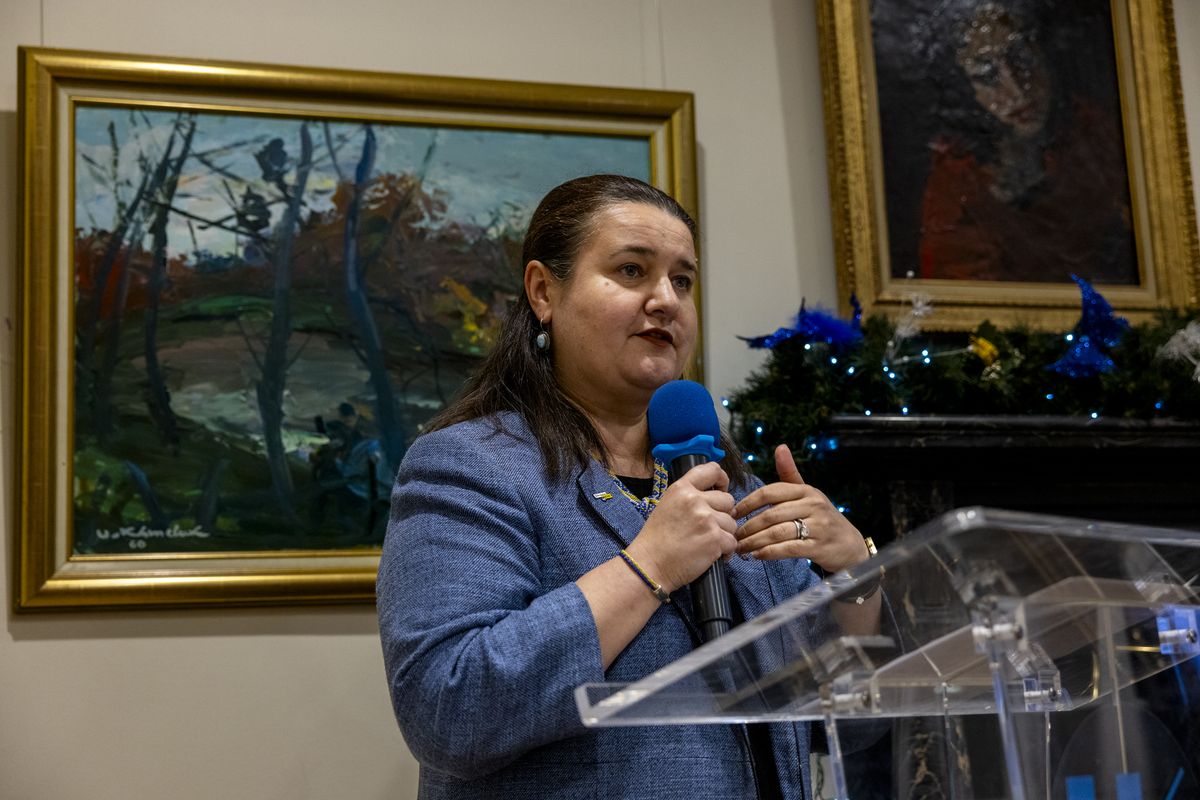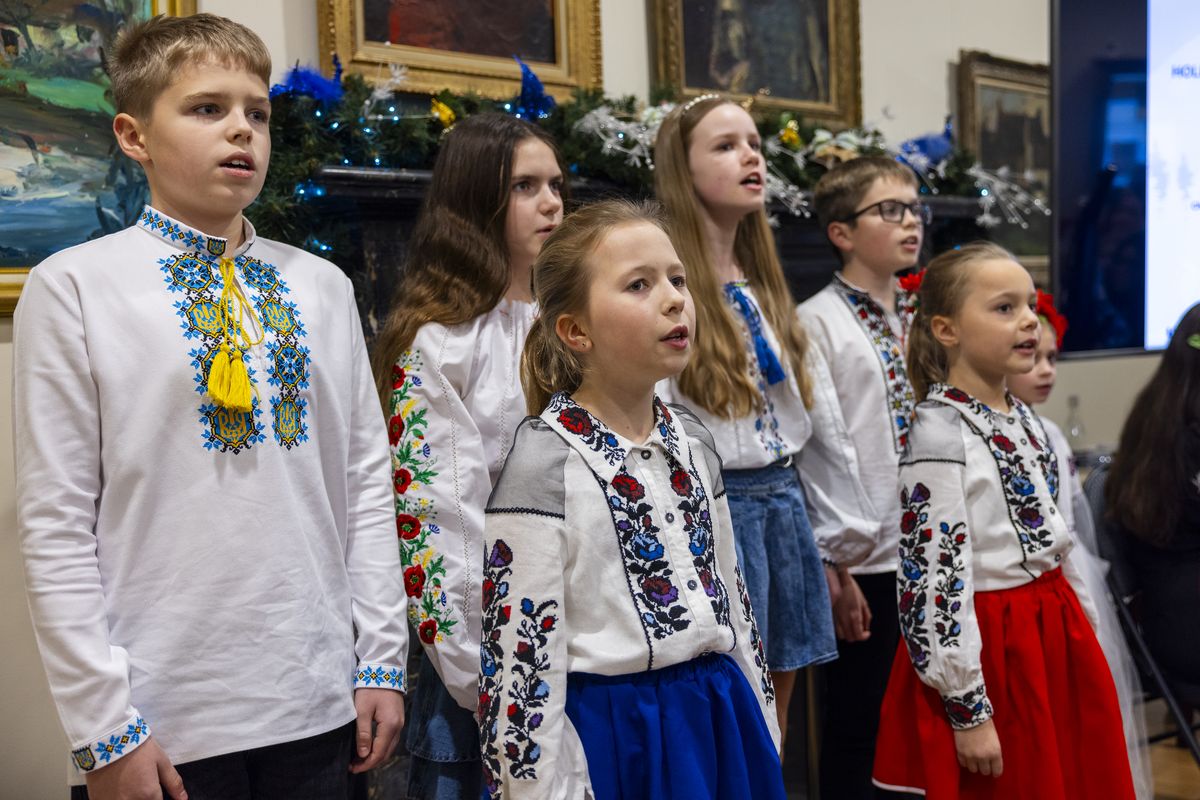The ‘Carol of the Bells’ comes from Ukraine’s fight for independence
The children’s choir from the Taras Schevchenko School of Ukrainian Studies in Bethesda, Maryland, performs at Ukraine House in Georgetown on Thursday. (Robb Hill/for The Washington Post)
It’s the repetition of those four notes that’s so insistent, that evokes tinsel and tinkling bells this time of year:
Ding, dong, ding-dong
Ding, dong, ding-dong
But it’s the historic repetition of that Ukrainian folk song over centuries - the one Americans know as “Carol of the Bells” that’s especially poignant and heartbreaking for a nation at war.
“It’s painful, but it’s also a call to action,” Oksana Markarova, Ukraine’s ambassador to the United States, said last week after hearing a children’s choir in Washington sing the ancient carol that she knows as “Shchedryk.”
The first time America heard the haunting melody was 1922, in Carnegie Hall, when the Ukrainian National Chorus was singing a global plea for independence after World War I.
“The Ukrainians are a singing people - they sing every event from great wars down to village festivals,” the United Press’s “Musical News” column in the Buffalo Times said on July 16, 1922, as the choir’s tour was announced.
The choir was assembled in 1919, amid the smoldering rubble of the war, by a Ukrainian army commander who was exhausted by bloodshed, and as the Paris Peace Conference was about to draw the lines of a new world order.
“This military man who cares for the liberation of his land from the yoke of tsarism and the Bolsheviks can do something better than just fight,” a European weekly wrote in 1920 about Supreme Commander Symon Petliura of the Ukrainian People’s Army.
What he did we now call “cultural diplomacy.” And Petliura is also the guy we can thank for those four haunting notes we hear every December.
In 1919, a continent reshaping after World War I faced the “Ukrainian question”: whether Ukraine would be an independent nation or divided among the newly formed Soviet Union, Romania or Poland. There was continued fighting in Ukraine until 1920, when most of the territory was absorbed by the Soviet Union.
Ukrainians fought to explain they were not “Little Russia,” as their lands were often called. They are a distinct people with their own culture. And song was at the heart of being Ukrainian.
To make its premiere in the spring of 1919, in Prague, the choir walked more than 600 miles as the Russian army advanced into Ukraine.
The centerpiece of the project to distinguish Ukraine as a culture and land separate from Russia through song was “Shchedryk,” which was arranged by beloved Ukrainian composer Mykola Leontovych. It was his choral take on a folk song that was usually sung around the New Year, the story of a swallow that came singing of hope, rebirth and bounty after the frigid winter.
It was the encore piece throughout the European tour, hailed as a masterpiece by critics and audiences showering the choir with flowers. Emotionally, musically and stylistically, it was stirring.
“So, gentlemen modernists, who need 20 lines of music to express their worthless thoughts, try to do it in four lines, like Ukrainian composers!” said a Czech music professor, marveling at the song’s concentrated power.
Those four notes - ding, dong, ding-dong - resounded across the continent.
A plea for rebirth, hope.
By the time the choir made it to New York, Ukraine was no longer a nation on the map, Washington didn’t recognize its diplomats and composer Leontovych was dead, killed by a Soviet agent in 1921.
Nevertheless, the music persisted. The choir was refashioned as the Ukrainian National Chorus and brought to America by music impresario Max Rabinoff.
The American crowds had heard about this “human symphony” and were clamoring for the thunderous, a cappella performance - the sound of an orchestra without instruments. It was a novelty.
“There are two very practical reasons for this,” said Marika Kuzma, a choral conductor and professor emeritus at the University of California at Berkeley who wrote a book about Ukrainian choral traditions.
First, the Byzantine Rite, which guides much of Ukrainians’ religious traditions, forbids instruments in church. Also, Kuzma said, there was staggering poverty that Ukrainians endured after cycles of war, conquests and occupations.
“These composers didn’t have money for food, let alone for hiring orchestras,” Kuzma told an audience in Georgetown last week, as she gave a talk about her book and the history of “Shchedryk.”
As soon as the singers disembarked from their ship in 1922, the Brunswick record company recorded “Shchedryk.”
Carnegie Hall was packed for the premiere on Oct. 5, 1922.
“The dynamics were extraordinary. The sudden forte struck like blows. The swells were like the heave of the deep sea. The diminishing chords at the end of some numbers were magical,” wrote the New York Herald’s W.J. Henderson.
“A company of singers who have been trained to the highest degree of technical perfection,” wrote the New York Tribune’s music critic Henry Edward Krehbiel.
All the newspapers introduced the group as the “Ukrainian National Chorus.” And deeper in their stories, all called the singers “Russian.”
The choir went on to give more than 400 concerts across the United States, Canada, Mexico, South America and in Cuba.
It was an American conductor of Ukrainian descent, Peter Wilhousky, who was in that Carnegie Hall audience and was haunted by that melody, those voices that sounded like repeating bells, for years. In 1936, he reimagined “Shchedryk” as a Christmas carol, rewriting the lyrics as the “Carol of the Bells” we know today.
Ukrainians had a tradition of singing the original song door-to-door after Christmastime, said Anthony Potoczniak, who wrote about the song’s history when he was an anthropology student at Rice University.
“But that wasn’t possible during the Soviet period,” Potoczniak said. “There would be some real consequences for anyone doing that openly.”
Potoczniak lived briefly in Ukraine after the fall of the Soviet Union in the 1990s. And he remembers the gusto with which Ukrainians brought “Shchedryk” back to the streets when they were free, reclaiming their heritage and independence. Briefly.
This story of “Shchedryk” is one that the Ukrainian ambassador said she will keep telling as she continues the plea for the world’s support since Russia’s invasion in 2022.
The ambassador was telling this story as the children’s choir from the Taras Schevchenko School of Ukrainian Studies in Bethesda, Maryland, prepared to sing “Shchedryk” at Ukraine House in Georgetown last week.
Outside the cultural center, the front lawn is decorated with Christmas lights and a children’s slide from a playground in Irpin, Ukraine that is riddled with bullet holes.
The children looked at it and held their parents’ hands a little tighter as they walked in.
“Listening to this beautiful music not only returns us to this period of holidays and Christmas,” Markarova said. “But it also reminds us that this fight for our independence is not something that happens in this century only. It reminds us that this is something that we needed to do during the previous century.”
Again and again.
Ding, dong ding-dong.
Ding, dong, ding-dong.



